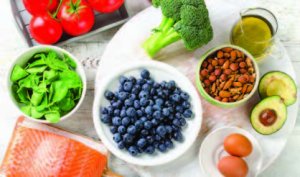by Specialdocs Consultants, LLC | Nov 20, 2017 | Nutrition, Patient News

Let food be thy medicine and medicine be thy food. – Hippocrates
Food’s healing properties is a concept that stems back to the earliest days of medicine, but has taken on new significance as a natural way to prevent or manage today’s most devastating illnesses, from dementia to heart disease. The regimens presented below are not ‘diets’ in the traditional sense, but rather represent a shift to eating habits that preserve wellness.
DASH (Dietary Approaches to Stop Hypertension), a low-sodium diet that encourages consumption of foods rich in nutrients such as potassium and calcium magnesium that help lower blood pressure, prevent diabetes and support heart health.
The Mediterranean diet emphasizes fish, fruits, and vegetables, with olive oil as the main source of fat, has gained prominence for its link to stronger bones, a healthier heart and reduced blood pressure.
Combining both of the above, the MIND (Mediterranean-DASH Intervention for Neurodegenerative Delay) diet, from Rush University Medical Center, shows real promise in helping patients maintain cognition and reduce the risk of dementia. Seniors who rigorously adhered to the recommended foods lowered their risk for Alzheimer’s disease by 53 percent, but even those who followed it only moderately well experienced a 35 percent reduction, according to newly published research from the Health and Retirement Study. The focus is on eating ‘brain-healthy’ foods, including:
Green leafy vegetables, such as spinach or kale – at least six servings weekly
- Other vegetables – at least one serving daily
- Nuts
- Berries – at least twice weekly
- Beans – at least three servings weekly
- Whole grains – three servings daily
- Fish – at least once weekly
- Poultry – at least twice weekly
- Olive oil
- Wine – once daily, if desired
Excluded: red meat, butter, margarine, cheese, pastries, sweets, refined sugar or flour, and fried or fast food. Eggs and dairy are included but in small portions.
Additional research points to the role of a high quality diet in preserving brain health and maintaining cognition. However, MIND study lead author and nutritional epidemiologist Claire McEvoy, Phd, cautions that to conclusively prove the connection between diet and dementia risk, the next step is to conduct clinical trials. In the meantime, experts say there’s no harm in incorporating these foods into your daily diet, as they provide antioxidants, assist with maintenance of normal blood pressure levels and help keep chronic inflammation in check.
Other plans worth considering:
Weight Watchers: still a smart, effective diet after 54 years. It’s rated high by dietitians for ease of adherence, nutritional soundness, emphasis on group support, abundance of fruits and vegetables, and allowance for occasional indulgences.
Mayo Clinic Diet: consisting of a two-week jump start for weight loss, followed by a lifelong approach to diet and health, with information on food choices, portion sizes, menu planning and physical activity. The emphasis is on generous amounts of low-energy-dense foods that help you lose weight by feeling full on fewer calories, and includes whole-grain carbohydrates, lean sources of protein and unsaturated fats. At least 30 minutes of exercise is recommended daily. A typical 1200-calorie-a-day menu includes:
- Breakfast: 1/2 cup cooked oatmeal with 1 cup milk and 2 tablespoons raisins, 1/4 cup mango, calorie-free beverage
- Lunch: Quinoa and sweet potato cakes, tossed salad with fat-free dressing, calorie-free beverage
- Dinner: 1 pita pizza, 3/4 cup mixed fruit, calorie-free beverage
- Snack: 1 cup sliced bell peppers and 2 tablespoons hummus
The post MIND Your Diet appeared first on Specialdocs Consultants.
by Specialdocs Consultants, LLC | Nov 20, 2017 | Nutrition, Patient News

As we become more aware of what comprises healthy eating, sugar is increasingly viewed with a wary eye. Evidence is mounting that a sugar-filled diet – and the resulting weight gain – can lead to increased cholesterol, blood pressure and inflammation, and to a higher risk of obesity and obesity-related conditions such as diabetes, pre-diabetes, cancer and cardiovascular disease (CVD). The key to prevention is understanding exactly what sugars you’re eating.
Naturally occurring sugars are found in foods such as fruit (fructose) and milk (lactose). Any product that contains milk, such as yogurt or cream, or fresh or dried fruit contains some natural sugars. These can be eaten freely.
Added sugars hide in 74 percent of packaged foods, even those that many consider healthy, such as energy bars. They also lurk in savory foods, including ketchup, breads, salad dressing and pasta sauce. The top five sources are sugar-sweetened beverages (soda, specialty coffees, sports drinks); grain-based sweets (cookies, cakes, pies); fruit drinks (juice cocktails, punch); dairy-based desserts (ice cream, frozen yogurt); and candy (lollipops, jelly beans). These should be limited.
“Consider the company the sugar keeps. If it’s accompanied by a nutritional element, it is not a contributor to disease,” advises Jennifer McDaniel, Academy of Nutrition and Dietetics spokesperson. For example, fruit contains fructose, but also fiber, which ensures the natural sugar is absorbed in a slow and controlled manner; the same applies to the protein in plain yogurt.
Guidelines for maximum daily amount of added sugars vary as follows:
- US Department of Health and Human Services: no more than 10% of total calories
- World Health Organization: encourages no more than 5%
- American Heart Association: no more than 6 teaspoons for women or 9 for men
While a complete sugar detox is not recommended – there is little evidence that it improves health or spurs weight loss – cutting back on added sugars to make room for healthier calories is strongly advised. McDaniel suggests:
- Look for the biggest offenders of added sugars in your diet, whether it’s chocolate or soft drinks, and replace them with something yo• look forward to eating.
- Make a super food swap. Enjoy a sweet bedtime snack? Consider blending a frozen banana with a splash of milk and unsweetened cocoa powder.
- Know your sweet tooth personality. If you’re an all or nothing person, it may be easier to eliminate your sweet triggers permanently, but if yo• can handle eating a square of chocolate without needing the whole bar, permit yourself the treat.
- Try the ‘Plain Jane’ version. When you’re in charge of the sweetness factor, you’ll almost always use less than presweetened version, so buy plain oats and add your own fruit and honey.
Can sugar be part of a healthy diet? Thankfully, yes. “It’s all about balance. The majority of our diet should be foods that nourish us, but there’s certainly a place for the sweet treats in life,” says McDaniel.
Sweet Disguise
It can be difficult to discern if a product contains both added and natural sugars, because the nutrition fact panels of food products don’t distinguish between them. That’s set to change in 2018 when federal regulations mandate the break out of added sugars. For now, be on the lookout for sugar in one of its many guises:
- Corn sweetener
- Corn, malt or maple syrups
- Fruit juice concentrates
- Honey
- Molasses
- Agave nectar
- Barley malt
- Cane juice
- Caramel
- Muscovado
- Turbinado
- Sweet Sorghum
- Treacle
The post Sweet Surrender: Is Sugar Off the Table for Healthy Eaters? appeared first on Specialdocs Consultants.
by Specialdocs Consultants, LLC | Mar 13, 2017 | Nutrition, Patient News, Wellness

The dieting-overeating-weight regain cycle is almost inevitable, not because people fail diets but because diets fail people. It is important to understand that rebound overeating happens to almost everybody, and should not be viewed as an individual weakness or fault. The main reason diets do not work over the long term is they create deprivation and promote a loss of the internal signals for hunger and fullness that are necessary for normal eating. In fact, dieting sets in motion physiological and psychological factors that actually trigger overeating.
How does mindful eating address the dieter’s dilemma?
Mindful eating begins when you ask: Do you know when you are hungry? Do you eat when you are hungry? Do you eat what you are hungry for? Do you stop when you are full? If you answered “yes,” you’re in tune with your body’s natural hunger signals. If you replied “no,” you may be out of touch with your true hunger needs.
How do you teach people to change their eating habits of a lifetime and adopt mindful eating?
It begins with learning how to identify your physical hunger. If you experience symptoms such as headaches, weakness, shakiness, irritability and lightheadedness, you may have waited too long to eat, and unfortunately, are now at high risk for overeating. Instead, look for an empty or gnawing feeling. The Hunger Scale above is a tool to help you evaluate your internal state. Ideally, you would stay in the range of ‘hungry’ to ‘full’ so you don’t become ravenous or stuffed. As you consistently ask yourself, “Am I hungry?” you will become better able to recognize your body’s needs.
The next step is deciding what to eat when you are physically hungry. When people eliminate categories of food in pursuit of weight loss, they frequently experience deprivation that ultimately leads to overeating the very foods they tried to avoid. Instead, think of what will truly satisfy you and supports your body as you make the match. Also take into consideration what will best support your body’s needs. For instance, those with high cholesterol might choose sorbet instead of ice cream if they are craving a cold, sweet snack. Consider not just taste, but feel – do you crave hot, cold, crunchy, smooth, salty, sweet, spicy, etc? If you eat what you are hungry for when you are hungry, you will find a moment when your stomach feels satisfied.
Is this process effective for most people?
Absolutely. The key is to be consistent and keep accumulating attuned eating experiences day in and day out.
Will I lose weight by becoming a mindful eater?
If weight loss occurs, it will be a side effect. However, I urge people to not use weight as a measure of success or failure. Health is so much more than just numbers on the scale, and a positive relationship with food along with a focus on physical activity, good sleep habits and regular medical care are much more important.
Did You Know?
33 – 66 Percentage of dieters that regain more weight than they lost on their diets
What is ‘mindful’ or ‘attuned’ eating?
Attuned eating teaches people to reconnect with their natural, inner signals that guide them as to when, what and how much to eat…literally bringing harmony into their relationship with food and allowing them to experience the real joy of eating. Mindfulness means bringing awareness to the experience without judgment or distraction. It is a transformative process that takes some time before people are able to honor their natural cues for hunger and satiety.
The post Try a New Approach to Food in the New Year: Stop Dieting and Focus on Mindful Eating appeared first on Specialdocs Consultants.




Recent Comments